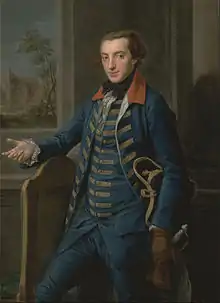William Weddell
William Weddell (13 May 1736 – 30 April 1792) of Newby Hall in the parish of Skelton-on-Ure, near Ripon in the West Riding of Yorkshire, was a British landowner and politician who sat in the House of Commons between 1766 and 1792. He created a notable collection of antiquities including the Barberini Venus.


Origins
He was born on 13 May 1736 as "William Elcock", the son and heir of Richard Elcock (d.1762) (who later adopted the surname of Weddell in lieu of his patronymic), later of Newby Hall, which he purchased in 1748. His great-uncle was Thomas Weddell of Earswick, Paymaster to the Navy, who made a large fortune during the South Sea Bubble.
Career
He was educated at Dr. Newcome's Academy in Hackney, and later at St. John’s College, Cambridge (1753), at the expense of his great-uncle Thomas Weddell, who bequeathed his fortune to Richard Elcock on condition that he and William should change their surnames to Weddell. He trained as a lawyer at Gray's Inn in 1753. In 1762 whilst on the Grand Tour, William Weddell became heir to his father, his elder brother having died.[1] William was thus in a position to start what became a renowned collection of classical antiquities, including the Barberini Venus, which sold in 2002 for £8 million. He upgraded and extended Newby Hall to house his collection.
He was elected a Member of Parliament for Kingston upon Hull in 1766, sitting until 1774. He was elected for Malton in 1775, serving until 1784, and again in 1784, serving until 1792.[2]
Marriage
He married Elizabeth Ramsden, a daughter of Sir John Ramsden, 3rd Baronet and a half-sister of Lady Rockingham, by whom he had no surviving children.
Death and burial
He died on 30 April 1792 and was buried in Ripon Minster (now Ripon Cathedral) where survives his unusual monument consisting of a representation of a Greek temple containing his bust by Joseph Nollekens.[1]
Succession
He had no surviving children and left Newby Hall to his distant cousin Thomas Robinson, 2nd Earl de Grey (1781-1859), then 3rd Baron Grantham, who in 1803 in accordance with the bequest changed his name to Weddell, but in accordance with a further bequest from his maternal aunt changed it again in 1833 to Grey.[3]
Further reading
References
- "WILLIAM WEDDELL'S REFINED TASTE". Ripon Civic Society. Retrieved 16 February 2013.
- "WEDDELL, William (1736-92), of Newby, Yorks". History of Parliament Online. Retrieved 16 February 2013.
- G. C. Boase, ‘Grey, Thomas Philip de , second Earl De Grey (1781–1859)’, rev. H. C. G. Matthew, Oxford Dictionary of National Biography, Oxford University Press, 2004; online edn, May 2009 accessed 9 Aug 2017
| Parliament of Great Britain | ||
|---|---|---|
| Preceded by Lord Robert Manners Sir George Montgomery Metham |
Member of Parliament for Kingston upon Hull 1766–1774 With: Lord Robert Manners |
Succeeded by Lord Robert Manners David Hartley |
| Preceded by Savile Finch Edmund Burke |
Member of Parliament for Malton 1775–1784 With: Savile Finch 1775-1780 Edmund Burke 1780-1784 |
Succeeded by Edmund Burke Sir Thomas Gascoigne |
| Preceded by Edmund Burke Sir Thomas Gascoigne |
Member of Parliament for Malton 1784– 1792 With: Edmund Burke |
Succeeded by Edmund Burke Hon. George Damer |